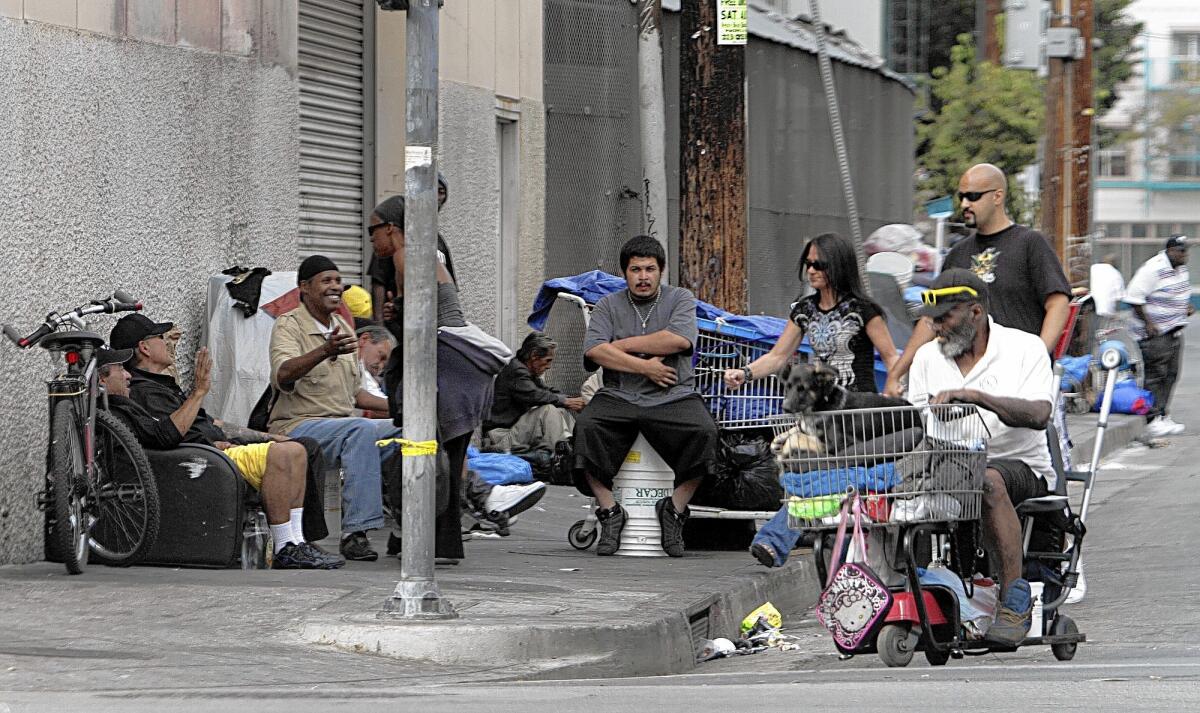L.A. budget official proposes $3.7-million skid row cleanup plan

- Share via
Addressing several lingering skid row conflicts, a top Los Angeles city budget official Monday proposed a $3.7-million cleanup plan that would increase 24-hour bathroom access for homeless people and expand storage for their belongings.
The proposal, which must be approved by the City Council, calls for setting up a skid row parking lot where homeless people could check in their shopping carts for the day. The plan would also increase an existing short-term storage operation by 500 bins, from 1,136 to 1,636, and move a 90-day storage facility east of Alameda Street into the heart of skid row.
The round-the-clock bathroom access would be provided at skid row shelters and social service agencies under contract to the city. Street cleanings and health inspections would also be stepped up, and the city would put a modest number of new trash cans on the sidewalks.
Chief Administrative Officer Miguel Santana, in a 10-page report, said the expanded services were requested by the City Council in response to an “overwhelming increase in need and decline in resources” on skid row since the Great Recession. Some 3,463 homeless people live in shelters and on the streets in the area, he said.
Since 2011, the city has been fighting a court injunction that prevents police from seizing and destroying homeless people’s unattended property. City Atty. Mike Feuer recently announced he was dropping the latest appeal of the injunction, but the underlying lawsuit has not been settled.
In both 2012 and 2013, the Los Angeles County Department of Health cited the city for immediate public health threats for feces and urine in the streets and called for more toilets.
Civil rights attorney Carol Sobel, who sought the injunction against property confiscation on behalf of eight homeless people, said the new plan is “at best inadequate.”
“It’s great adding new storage units, but these will fill up very, very quickly,” she said. “And it’s got to be open when people need it.”
She also complained that the expanded bathroom access was clustered in one area — too far from some of the homeless encampments.
Feuer and Mayor Eric Garcetti expressed support.
“I am committed to that vision of a better skid row, and am optimistic we can get there,” Garcetti said in a statement.
Spokesman Jeff Millman said the mayor supported a “reasonable settlement” of the homeless belongings lawsuit.
Other advocates said the proposal would do nothing to eliminate homelessness on skid row.
“Shouldn’t we expect … a lot more action than this, which isn’t even managing homelessness, but just managing feces and garbage?” said retired UCLA law professor Gary Blasi.
Compared with successful efforts to end street homelessness, the proposal “only emphasizes how far behind the rest of the country Los Angeles is,” Blasi added.
The reaction on skid row Monday afternoon was mixed.
“How come we can’t just give them housing?” said Terrance Dunn, 52, who was resting on 6th Street.
Jackie Breland, a case manager at the Midnight Mission, said the shopping cart parking lot was a “great idea” but probably wouldn’t keep the sidewalks clear of people’s belongings.
“I remember they cleaned this whole side of the street a while ago, and now it’s back,” he said, gesturing toward a row of plastic-draped carts.
The $3.7 million for fiscal year 2014-15 is an increase of $2.2 million over the 2013-14 budget for skid row hygiene and sanitation, Santana said. Many of the changes are planned to be phased in starting in May and June.
Other specifics include:
•An increase of 10 trash receptacles, to 27.
•An increase from four to six comprehensive multi-day street cleanings a year, and boosting spot cleanings to 12 a year.
•The addition of two full-time environmental compliance inspectors.
•Expanded hours for toilets and showers at four skid row shelters. Adding portable toilets was rejected because of opposition from businesses and the LAPD, which noted “they have been used in the past for prostitution, drug dealing and usage, and other criminal activity,” Santana said.
•The “valet cart storage” at the Weingart Center parking lot.
Santana said the plan would help the city better meet health and safety standards, but he doesn’t expect to wipe out street encampments. Under a separate court settlement, homeless people are allowed to sleep overnight on city sidewalks but are required to get up and move their property by day.
“It’s impossible to reach 100% compliance,” Santana said.
More to Read
Sign up for Essential California
The most important California stories and recommendations in your inbox every morning.
You may occasionally receive promotional content from the Los Angeles Times.










